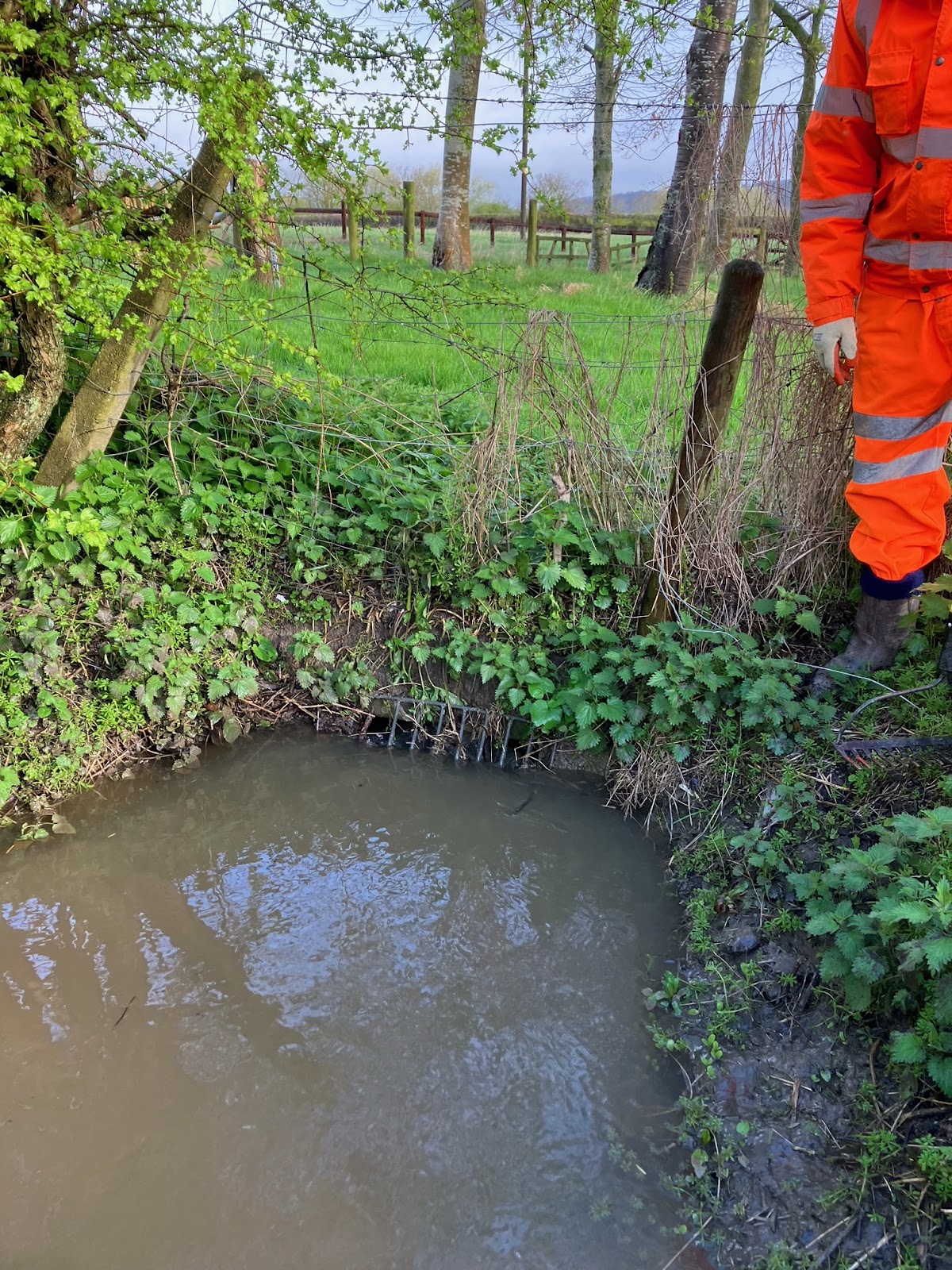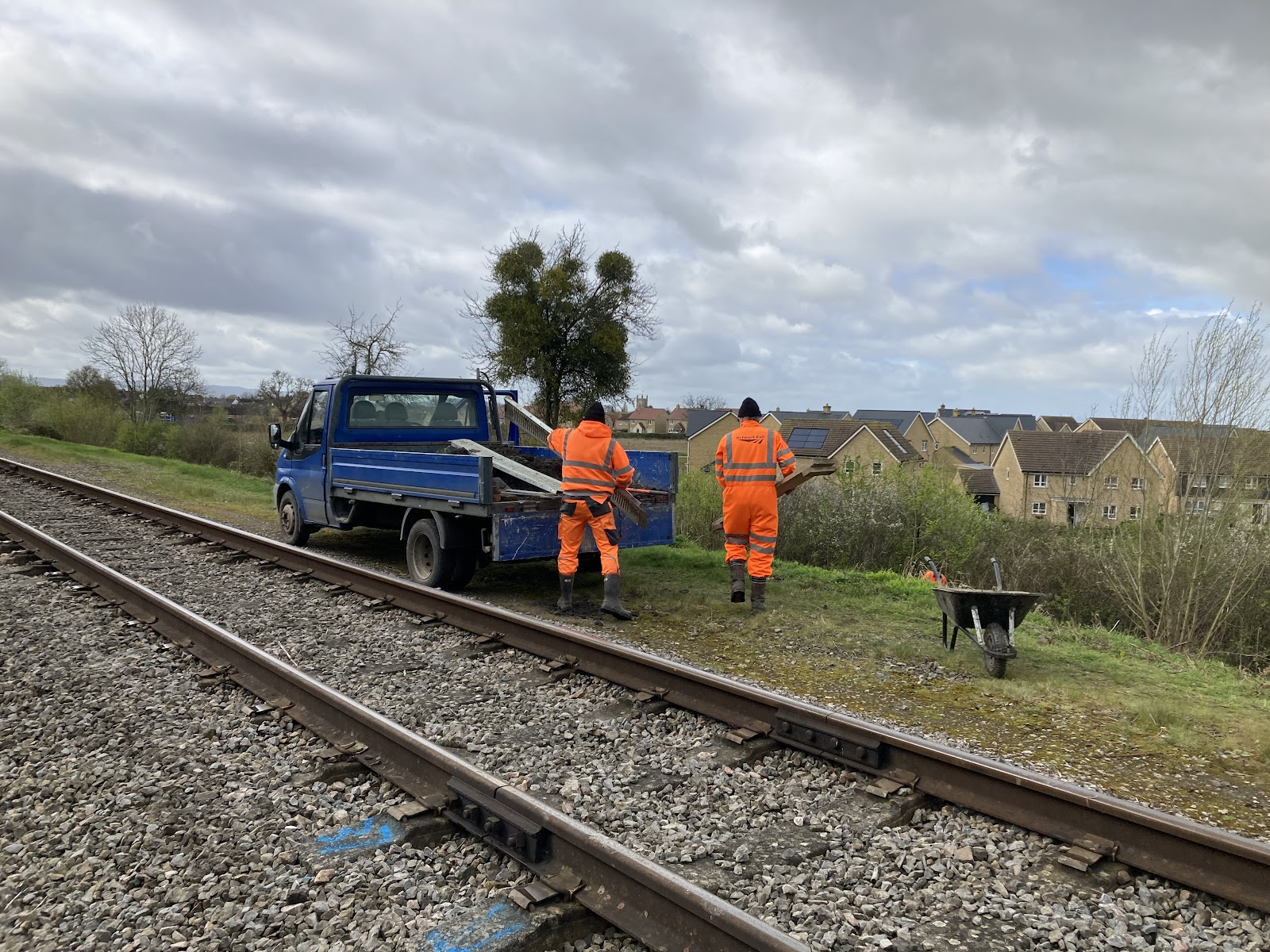Thursday 28th March
Seven of the team in attendance - all involved with earth moving. Actually at Gotherington the earth was mostly clay and at Woodmancote it was silt.
Ian attended Toddington to assist with the unloading of the Broadway spoil wagons into Ken Pink's tipper lorry. The Heritage Herald blog post “A grab lorry came” has some pictures and a description of this part of the operation.
Jonathan and Andrew went to Gotherington Yard to handle the unloading of the spoil. The telehander was used to get most of the first load, which was almost entirely clay, into the hollow behind the inlet headwall of culvert 33B. Because of the slope and the limit of the telehandler boom, quite a lot of this load was placed by lifting over the boundary fence. The heavy manual processes were moving the clay off the lids of the chamber by the boundary fence - and removing that which was getting stuck in the telehandler bucket. Just like the folk at Toddington, we found this clay stuck to everything! The third full load and the final part load did have less clay content - these were tipped between the entrance gate and the culvert ditch. At least there was very few broken bricks and other debris in the spoil. We will be using the piled spoil as backfill for various structures south of Gotherington in the next few weeks. Whilst at the yard with the telehander, we took the opportunity to tidy the piles of ballast and increase the parking area - it should now be possible to turn the trailer with the minidigger on it there.
 |
| Making room for the tipper lorry to dump the Broadway spoil at Gotherington Yard. |
 |
| First load of spoil arrives - grab out of way to enable tipping. |
 |
| Second load is tipped. |
 |
| Temporary shuttering to prevent spoil entering the ditch of culvert 33B. |
Meanwhile Dave, Nigel, Stuart and Martin paid a second visit to the mobile home park at Woodmancote. They removed yet more silt from the down (Cotswold) side toe ditch between culvert 38A and Station Road. This caused the level in the inlet pond to drop significantly - which revealed at third inlet pipe. This and the second (middle) pipe resisted all attempts of clearing with the rods with a corkscrew head - probably the pipes are obstructed by tree roots. There are some willow tress growing on the line of the pipe around 20 yards from the exit. Most of the flow into the ditch was coming from the inlet pipe closest to the track; and the flow noticeably increased following a heavy shower of rain. We believe the road gullies in Station Road feed into this. Once we get a drier spell of weather, we plan to investigate the many watercourses in this area. This toe ditch is now flowing well down the whole length to the inlet of culvert 38A; so hopefully will not require any more work until the autumn.
 |
| Now three inlet pipes to the mobile home to ditch! [Photo by Dave] |
 |
| Cleared and deepened ditch - flowing well. [Photo by Dave] |
Back at Winchcombe after a late lunch we moved two completely painted lengths of bridge rail out of the shed and then painted the undersides of three lengths of bridge rail. These three lengths should therefore be ready for flipping over to paint their top sides next time we want to escape the worst of any rain.
Wildlife report: As ever robins were very quick to investigate the disturbed soil at both sites. At Gotherington a large flock of crows were noted, occasionally mobbing some buzzards.
Thursday 4th April
Fortunately the very heavy overnight rain had stopped by 8am and the days rain did not start before we finished - so at last we had a dry day. That is excluding the water on the ground! The overnight rain was extremely heavy - team members coming in from west of the Severn and north of the Avon reported a lot of flooding.
Six of the team attending. Initially Dave, Nigel and Martin headed for Working Lane to clear the exit grill of culvert 24C on the up side at the foot of the haul road. This is a regular task - the grill gets obstructed with twigs and small debris. It is far better the obstruction is on the grill than a blockage inside the pipe. Removal only takes a few minutes and then the water drops; over 6 inches today.
 |
| 24C exit before cleaning of the grating .... [Photo by Dave] |
 |
| ... and after cleaning. [Photo by Dave] |
The main task of the day was backfilling of culvert and cross drain head and wing walls between Gotherington and Bishops Cleeve. As most of those which required attention were on the down side, we deployed a barrow crossing. Hence we had arranged a line possession with the Operations Manager and installed stop boards at Manor Lane. This was possible as public trains on Thursdays do not start until next week. Jonathan manned the telehander for loading at Gotherington Yard, whilst Roger and Andrew delivered the first load of spoil. Dave, Nigel and Martin collected a second load of spoil. We used all this to backfill both sides of 37B, and the down side of 37C, 37E, 37F and 37G. Additionally we measured up 37B through to 37G for headwall safety markers. These will help all staff and contractors working lineside to spot where the headwalls are, particularity in the summer after the vegetation has grown.
 |
| Cross drain 37G is unusual in that it does not pass under the railway - it goes under the footpath which runs under bridge 38. |
 |
| Roger and Nigel load up after delivering the final barrow loads of spoil at cross drain 37G. |
Meanwhile at Gotherington Yard, Jonathan used the telehandler to further tidy the piles of spoil and ballast. There is now plenty of room for manoeuvring vehicles and for another delivery or ballast. It was still too wet to complete the levelling out of the ex-Broadway spoil behind the inlet headwall of culvert 33B.
Following the heavy rain overnight there was a lot of water running off adjoining fields. At Gotherington we noted on the down side water flowing from the field by cross drain 33A - there is a shallow ditch there; we have added a task to deepen that.
 |
| Run off water from the adjoining down side field collecting behind the wall of cross drain 33A inlet channel. [Photo by Roger] |
At Woodmancote, the stream which becomes culvert 37G was overflowing outside of railway land, probably due to obstructions in the pipe under the footpath. Most of the water is then flowing down the footpath and pooling under bridge 38; walkers beware!
 |
| Water flowing down the footpath then under bridge 38. |
We checked on the state of the toe ditch on the down side alongside the mobile homes between culvert 38A and Station Road bridge. The work there in the past two weeks has paid off - the level of the ditch was well down, enough to see two thirds of the inlet pipes. We have confirmation that this ditch does carry the runoff from the road drains in Station Road. So no doubt earlier in the day it was flowing stronger.
After another late lunch at Gotherington, we headed back to Winchcombe. A spot more painting of bridge rail lengths for mileposts and some plant maintenance tasks were completed. The later covered work on our cement mixers, the generator and a wheel change on a wheelbarrow. We noted that the flat tyre we replaced was marked “General Wheelbarrow Tire”!
A check was made on the level of the River Isbourne - it was certainly too high and the flow too fast to have safely progressed the wing wall rebuilt.
Wildlife report: The highlight was a very close encounter with a muntjac deer - we disturbed it in the vegetation near bridge 38. Otherwise the most noticeable item was the number of butterflies, mainly cabbage whites, no doubt due to the welcome sunshine. Two more positive plant identifications (at Gotherington): common comfrey (Symphytum officinale) and Thyme-leaved speedwell (Veronica serpyllifolia).

No comments:
Post a Comment